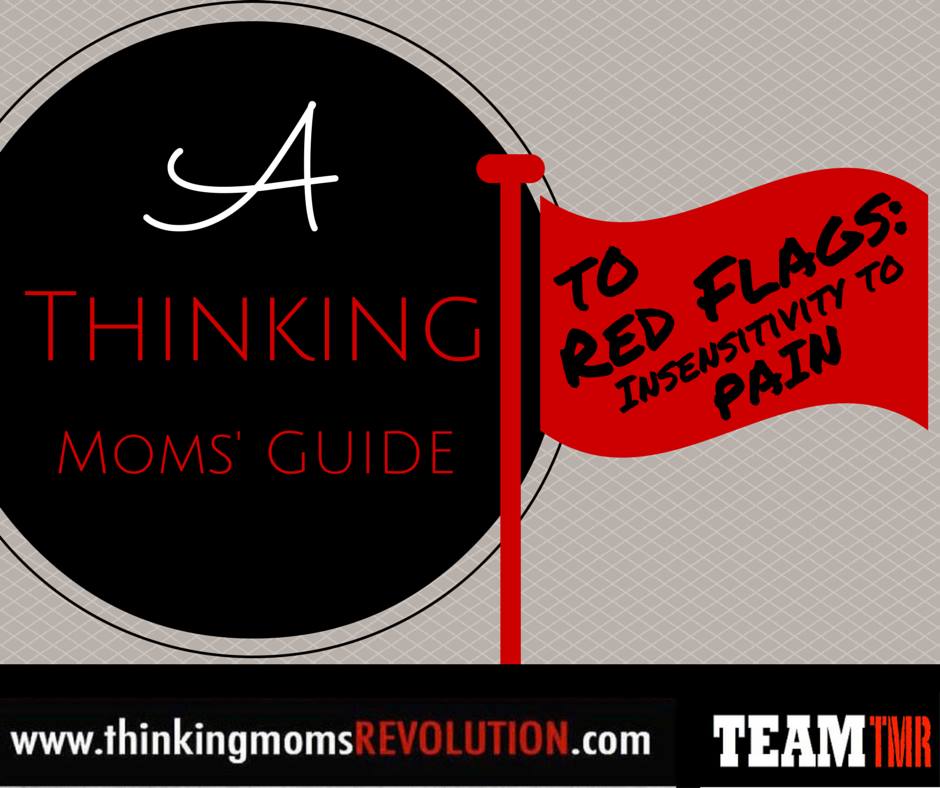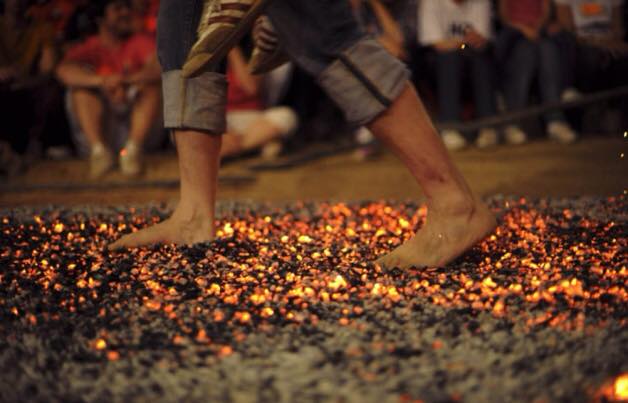 When my daughter was about 2 1/2 years old, she was following me upstairs and fell forward a little and the heel of my shoe caught her lip. I turned around to ask if she was okay, and she just sat down on the stairs for a moment, made a whiny “ugh” sound, then proceeded up the stairs as if nothing happened, blood running down her chin. It baffled me. I remember thinking, “Wow, this kid is as tough as nails.” She screamed half the day for no apparent reason, but cut her lip and no problem. Just like any child, she had her fair share of scrapes, bumps and bruises, but her reaction to them was surprisingly limited.
When my daughter was about 2 1/2 years old, she was following me upstairs and fell forward a little and the heel of my shoe caught her lip. I turned around to ask if she was okay, and she just sat down on the stairs for a moment, made a whiny “ugh” sound, then proceeded up the stairs as if nothing happened, blood running down her chin. It baffled me. I remember thinking, “Wow, this kid is as tough as nails.” She screamed half the day for no apparent reason, but cut her lip and no problem. Just like any child, she had her fair share of scrapes, bumps and bruises, but her reaction to them was surprisingly limited.
It is not uncommon for parents of children on the spectrum to report that their children have an unusually high pain tolerance. Of course, this was just another red flag that I missed before my daughter was diagnosed and probably the last thing I would have connected to a developmental disorder. Ah, hindsight, right?
If you have a child who does not have a diagnosis and he or she seems highly unaffected by painful stimuli, I would recommend bringing it up to your doctor. Being insensitive to pain can be caused by a number of reasons, including a congenital disorder known as CIP (congenital insensitivity to pain). This is a very serious and rare condition in which the person cannot perceive physical pain. However, it is not the type of pain insensitivity I want to discuss with you today.
 Pain is subjective, and so, just like with autism, there is a spectrum depending on the child’s personality, what initiated the pain and how well his or her nervous system is functioning. What seems like a higher-than-normal pain tolerance can be a red flag that your child’s nervous system is not functioning properly or is being influenced by an environmental factor, especially diet, as was my daughter’s case. An abnormally high pain tolerance in a child with a known developmental delay is a good indication that a trial period of a gluten and casein-free diet is in order. The reason for this being that, once ingested, these foods break down into opiate-like substances. Coupled with a leaky gut, these substances can leak into the bloodstream, cross the blood-brain barrier and cause a “high,” just like the well-known opiate morphine (see websites listed below for research and discussion of this phenomenon). Opioids have the ability to affect the intensity with which we feel pain. And, what happens after you come down from a high? How does that make you feel? Pretty bad, right? Wanting more, right? Cranky and inconsolable maybe? On a side note, opioids also affect behavior and can play a part in a person behaving coldly as if he or she lacks an ability to respond interpersonally. It has been noted in the scientific literature that opiate addiction and autism have similar attributes behaviorally.
Pain is subjective, and so, just like with autism, there is a spectrum depending on the child’s personality, what initiated the pain and how well his or her nervous system is functioning. What seems like a higher-than-normal pain tolerance can be a red flag that your child’s nervous system is not functioning properly or is being influenced by an environmental factor, especially diet, as was my daughter’s case. An abnormally high pain tolerance in a child with a known developmental delay is a good indication that a trial period of a gluten and casein-free diet is in order. The reason for this being that, once ingested, these foods break down into opiate-like substances. Coupled with a leaky gut, these substances can leak into the bloodstream, cross the blood-brain barrier and cause a “high,” just like the well-known opiate morphine (see websites listed below for research and discussion of this phenomenon). Opioids have the ability to affect the intensity with which we feel pain. And, what happens after you come down from a high? How does that make you feel? Pretty bad, right? Wanting more, right? Cranky and inconsolable maybe? On a side note, opioids also affect behavior and can play a part in a person behaving coldly as if he or she lacks an ability to respond interpersonally. It has been noted in the scientific literature that opiate addiction and autism have similar attributes behaviorally.
 My daughter had absolutely no patience when she wanted to eat. None. She also ate copious amounts of food (gluten and casein-containing foods, that is). She completely stuffed herself with them. I was amazed that such a little kid could fit so much into her tiny stomach. Afterward, she would be much happier — a drug addict who had her fix.
My daughter had absolutely no patience when she wanted to eat. None. She also ate copious amounts of food (gluten and casein-containing foods, that is). She completely stuffed herself with them. I was amazed that such a little kid could fit so much into her tiny stomach. Afterward, she would be much happier — a drug addict who had her fix.
If you have a child that appears to have an unusually high pain tolerance, here are some suggestions:
 Pay attention to exactly what your child is eating. Is he or she self-limiting with food? Does most of his or her food contain gluten and/or casein?
Pay attention to exactly what your child is eating. Is he or she self-limiting with food? Does most of his or her food contain gluten and/or casein?- Does he or she gorge on these foods?
- Is he or she cranky and impatient when hungry and very happy or giggly and silly after eating?
- Consider a trial period with a gluten and casein-free diet. There are so many great sites on the internet to help you get started, or you can always ask another Thinking Mom . . . we love to help! Please remember here that consistency is the key, and this really has to be done all the way to see if these foods are what is causing the insensitivity.
- Talk to your doctor about your concerns. It is possible that more is going on than just food issues.
- It is also important to note that toxic metal exposure (such as mercury or lead), whether acute or chronic, can damage the nerves leading to pain insensitivity (in which case, you might want to consider chelation to remove the metals and/or reflex integration to improve your child’s neurological function).
xoxoxo
~ Chief
Chief is a southern-born-and-bred Registered Nurse and mom to Madison, who is recovered from autism. She has settled nicely into her crunchy-mom role, after years of working to heal her daughter. She says if you need her, check the grocery store or her kitchen, where she whips up gourmet SCD cuisine. Just kidding; it’s chicken and carrots.
Resources:
GFCFdiet.com: Explanation of GFCF Diet
Gluten-free.org: Collected Net Articles of Kalle Reichelt, M.D.

















I have two sons with similar biomedical issues (the eldest was about 75% of the way to an ASD diagnosis before we started biomedical intervention age 3, now mostly recovered). The eldest has excessive pain sensitivity, the youngest has too little sensitivity. As their health has improved, they have both moved more towards the middle of the range.
I’d just like to add that there’s a flip side to this coin that’s equally concerning: amplified pain. My son had amplified pain (for instance, he scraped up his knees and didn’t walk for 10 weeks) that subsided when we started the GFCF diet. I think it’s kind of like people who’ve been on pain meds for a long time have a lower pain threshold after a while… No one knew what to make of it and it preceded his autism diagnosis by a few months. In hindsight it was part and parcel of the whole dysregulated sensory integration function. Sigh. Just another red flag that was completely missed. Good job Chief!
I know how gluten and casein foods make me feel and I am an adult who is largely unvaccinated. I stopped eating these foods about 2 years ago in a last ditch attempt to control severe hay fever. Within 2-3 weeks the hay fever was gone AND my knees no longer hurt, I started to lose weight, I woke up feeling good instead of fatigued and achy. My overall health has improved greatly. I am just about never ill and haven’t taken a day off work in over 18 months. I didn’t expect anything but an outside chance to lessen my hay fever so everything else was a bonus! My only regret is that I didn’t listen to the naturopath who told me to give up wheat and dairy 15+ years ago.
Thank you TMR. You gals and guys and your beautiful kids are an inspiration.
We here in Australia are trying to stop our right to choose whether to vaccinate from being taken away from us. My kids are grown but my grandkids I fear for. We are watching what happens in CA closely and have already planned rallies in some cities. The revolution is well under way!
I hope you’re very encouraged by what happened today in California, Jennifer. I’m watching Australia, too, because my kids have relatives there. Good luck!
I equate this to being so “sedated” that one cannot complain about pain, though they are feeling it plenty. Like when I was injected with pain medication while having a kidney stone episode, and was so sedated I couldn’t communicate, but was still in excruciating pain. The nurse thought I must have passed the stone. Wrong. I was pleading with her with my eyes.
Check your child’s heart rate when he/she is injured and compare it to their resting heart rate. You might be surprised.
This still happens with my child even though she has been GFCFSF for years. It is heartbreaking to witness.